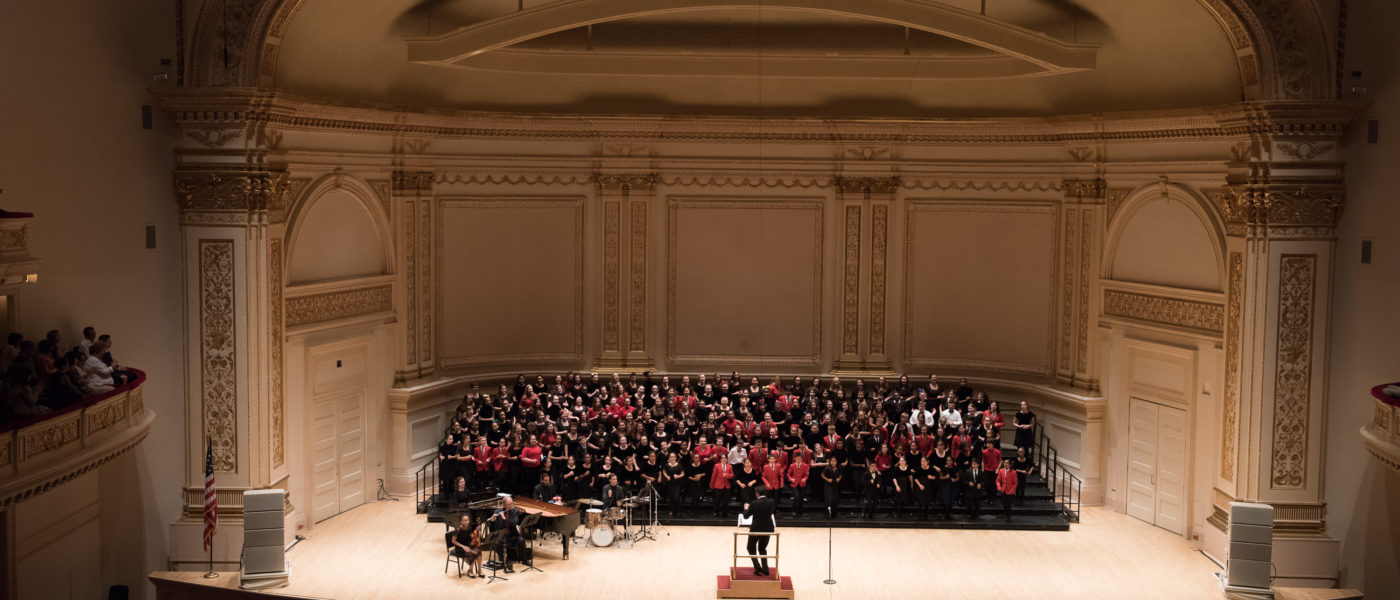Distinguished Concerts International New York (DCINY) presents Canta! Canta! Canta! in Review
Distinguished Concerts International New York (DCINY) presents Canta! Canta! Canta!
Cabrillo Symphonic and Youth Choirs, Cheryl M. Anderson, conductor
Ensemble Monterey Chamber Orchestra; Cabrillo Symphonic and Youth Choirs, John D. Anderson, conductor
Distinguished Concerts Singers International
Francisco Núñez, composer/conductor; Kristen Kemp, piano; Steve Picataggio, percussion
Stern Auditorium at Carnegie Hall, New York, NY
June 26, 2017
The final choral offering of the 2016/17 season presented by Distinguished Concerts International New York (DCINY) fell into two highly contrasted halves, musically and culturally, the whole making a complementary and enjoyable evening.
The first two offerings were by Latvian composer Ēriks Ešenvalds, who has become highly sought after in his field. His music evokes natural and cosmic vistas with beautiful use of accessible diatonic tunes, tone clusters, soaring descants, and good quality texts. The Long Road is a Latvian poem (sung here in English translation) about a young woman whose lover she has lost to war, she yearns for their reunion but realizes that that may constitute a “long road.” As conducted by Cheryl M. Anderson, the radiance of the music perfectly underscored every line of text, which was rendered crystal clear by the large choir.
Then followed the New York premiere of what one might term an “environmental” piece: Mr. Ešenvalds’ Sunset in My Hand: Ancient Voices of the Wild Pacific Coast. The work was extremely effective at portraying the moods of the sophisticated poems (by Teasdale, Neruda, Gioia, Steinbeck, Jeffers, and an anonymous Franciscan monk) as each one of them contemplates a different aspect of nature, hence reflecting upon themselves too. John D. Anderson led the group beautifully. One of the movements, Prayer at Winter Solstice, contained a slow-ticking metronome, with which the choir was deliberately supposed to sing “out-of-sync” to show the difference between measured time and “felt” time. This was the only problematic movement for me, as the metronome interfered with the gorgeous choral output. My personal favorite was Evening Ebb, a meditation at sunset on the ocean shore. Its rising and falling palindromic cluster chord repetitions were stunning. The inclusion of an Ohlone chant (the indigenous tribe of the San Francisco/Monterey region) in the final section, I Hold the Sunset in My Hand, was a nod to California’s colonial history.
My only suggestion to Ēriks Ešenvalds would be to create more variety of tempo in his otherwise transcendent output. Everything sounds very stretchy, like slow floating. I would have liked to hear this central-California coastal group cut loose in something with a bit more rowdy energy.
After intermission, Francisco J. Nuñez took the stage with his own renowned Young People’s Chorus of New York City, part of a composite group that included many other children’s choirs from across the US. Mr. Nuñez is a recipient of the prestigious MacArthur Foundation Fellow “Genius” grant, and has devoted his life to the creation and commissioning of quality accessible choral materials for children, works that will teach not only musical skills (while providing enjoyment) but also moral precepts such as diversity, strength, and faith.
His set was mainly of shorter “fun” pieces like the traditional Spanish song De Colores (colors of the rainbow and sounds of animals) and Pinwheels (joy of young people spinning and turning), but the Misa Pequeña Para Niños, an abbreviated Catholic Mass setting in Spanish was a novelty to me—its tiny dimensions coordinating with the children singing it. Four young soloists with great self-possession fulfilled the brief solo parts nicely. May I also note that the choir’s diction was clear as well, an accomplishment not so easy to achieve. An uncredited duo, one playing flute/piccolo/clarinet, the other violin, added excellent evocative sonorities to the piano and percussion.
The concert concluded with a rousing performance of La Sopa de Isabel (Elizabeth’s soup), a merengue that involved all manner of eurhythmic clapping, stomping, turning, etc. Mr. Nuñez’s sheer joy in this work was front and center, his hips grew ever looser with each repetition, and it was clear how much the children enjoyed working with him and he with them.

